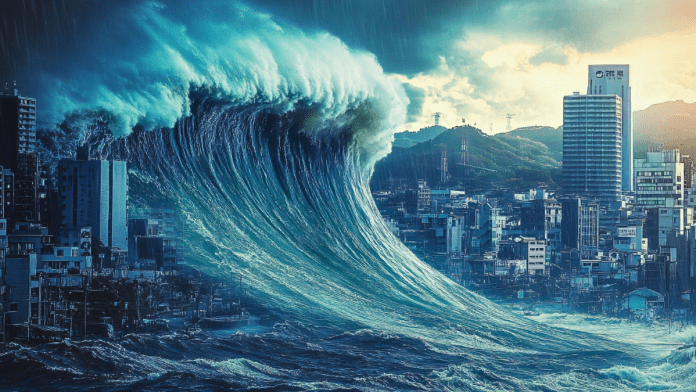🕒 Last updated on July 30, 2025
A powerful earthquake measuring 8.8 in magnitude struck off the coast of Russia’s Far Eastern Kamchatka Peninsula on Wednesday.
A Massive Earthquake Shakes the Kamchatka Peninsula
Just 119 kilometers from Petropavlovsk-Kamchatsky, it took place beneath the sea. In the early hours of the day, the ground started to shake. People ran out of buildings in fear, and many sought safety on higher ground.
It was only 19.3 kilometers deep, according to the U.S. Geological Survey. Shallow quakes tend to cause more damage. A strong aftershock measuring 6.9 also followed shortly after the main quake. Officials in the region called it the strongest earthquake in decades.
A tsunami was quickly triggered by the quake. On the Kamchatka beach, waves reached a height of 4 meters (13 feet). Authorities advised everyone to avoid the shoreline. Emergency officials said several buildings were destroyed, including a kindergarten. A few people were injured while trying to escape the tremors—some even jumped from buildings.
A fish processing plant and a port in the town of Severo-Kurilsk were inundated. People were evacuated from coastal towns, and the new airport terminal in the region also suffered some damage. Luckily, no serious injuries or deaths were reported.
📢 Sirens Scream Across Alaska—Tsunami Fears Surge After Massive Quake Strikes Ocean Floor
Japan Orders Coastal Evacuations Amid Tsunami Alerts
Russia was not the only country affected by the earthquake. Japan responded quickly because it was still remembering the 2011 earthquake and tsunami tragedy. Large swaths of the Pacific coast were warned of tsunamis by authorities. They feared waves up to 3 meters high could hit the shore.
Particularly on the northern island of Hokkaido, villages and cities were filled with the sound of tsunami sirens. Public broadcaster NHK showed people taking shelter on rooftops. Many fishing boats left their harbors to avoid being destroyed by the waves. Families rushed to evacuation centers, and people moved away from the coast to find higher ground.
Even the Fukushima nuclear power plant, which had a meltdown in 2011 after a tsunami, was evacuated. The plant’s operator said that all workers were safely moved out, and there were no irregularities found.
Japan’s Chief Cabinet Secretary said that so far, there were no reports of injuries or damage, and only small tsunami waves were recorded. But the warning remained in place as a safety measure for everyone living near the coast.
Widespread Tsunami Warnings Across the Pacific
The impact of the quake didn’t stop in Russia and Japan. The U.S. Tsunami Warning System issued alerts for many countries around the Pacific Ocean. It warned that waves over 3 meters could reach the coasts of Russia and Ecuador. Hawaii, Japan, Chile, and the Solomon Islands all have the potential to experience waves of one to three meters.
Smaller tsunami waves could even hit places along the U.S. West Coast. Hawaii quickly responded to the warnings. Authorities there ordered evacuations from low-lying coastal areas. Emergency alerts were sent out urging people to move to higher ground or at least to the fourth floor of buildings.
🌊 Freshwater Vanishing at Alarming Speed — Four Mega-Regions Face Collapse
In Hawaii’s capital, Honolulu, sirens wailed, and beachgoers were told to leave immediately. Roads filled with cars as residents tried to get to safe places. The local emergency department warned, “Take Action! Destructive tsunami waves expected.”
Many people across the Pacific were deeply worried as updates came in. People living near the coast kept checking for alerts and followed safety instructions. Boats were moved away from ports, and beach areas were cleared as a precaution.
The earthquake also reminded experts that Russia’s Far East lies along the Pacific “Ring of Fire.” This area is one of the most earthquake-prone regions in the world. It’s known for its frequent seismic activity and volcanic eruptions.
The Russian Academy of Sciences confirmed that this was the strongest quake in the region since 1952. But experts said that the shaking wasn’t as intense as expected due to certain features of the epicenter. Still, the aftershocks continued, and people were told to stay alert.

